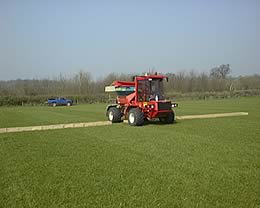 |
|||||||||
|
|||||||||||||||||||
| Cost-Effective
Calibration In Lead Up To Grassland 2005 24/02/05
“Inaccurate spreading reduces yields and the financial losses can be significant,” says Mr Leadbeater. “Evenness is measured by the Coefficient of Variation or CV. The lower the CV value the more even the spread. “It's not until you reach a CV of 20% that you would expect to see visible striping in a field but economic losses can occur well before then,” he adds. “In a typical grass silage situation the difference between achieving a 10% CV and a 20% CV would be around £25 a hectare - that's a £25 per hectare saving simply by calibrating your spreader for both application rate and spread pattern.” Managing director of Spreader and Sprayer Testing Rob Foxall, who is exhibiting at Grassland 2005 in May is amazed at how many grassland farmers forget, or do not even consider, having their spreader equipment checked and calibrated. “A comprehensive calibration and tray test could cost as little as 79p per tonne on a typical farm using 150tonnes of fertilizer a year,” he says. “This is very cost-effective when you consider the loss of yield from under applying, or the extra cost of unnecessary fertiliser associated with over application. Also, too much nitrogen might cause high nitrogen contents in silage that can adversely affect quality and intakes. “In addition, correct calibration reduces the possibility of accidental contamination of watercourses and hedge bottoms, and the risk of nitrate leaching.” The calibration process consists of a full 'MOT-type' check of the spreading machine. “Ideally this should be done annually and before the spring rush,” says Mr Foxall. Operating a team of 12 engineers across the UK, the most common faults found by the company are incorrect PTO speeds and agitation, and worn vanes. “It is important to test the tractor PTO speed,” he adds. “When it says 540 in the tractor, is it actually doing 540?” Another very important part of the check is a full width tray test of the fertiliser to be spread and a flow rate and application rate test. “And even when all the working parts are in good order, it is surprising how often the machine is set up wrongly for the particular fertiliser to be spread - height, tilt, vane angle and the drop on the guides all need checking before starting to spread.” Held every three years, the Grassland Event aims to attract more than 12,000 visitors to the two-day exhibition on 18/19 May. Incorporating the Muck Event, Grassland 2005 will include working demonstrations of grassland machinery and muck handling equipment. The event is targeted directly at all grassland farmers and agricultural contractors. |
|||||||||||||||||||

|
|
||||||||||||||||||
| home | agri-services | pedigree
pen | news | dairy | beef | machinery | property | organisations | site map |
|||||||||||||||||||
